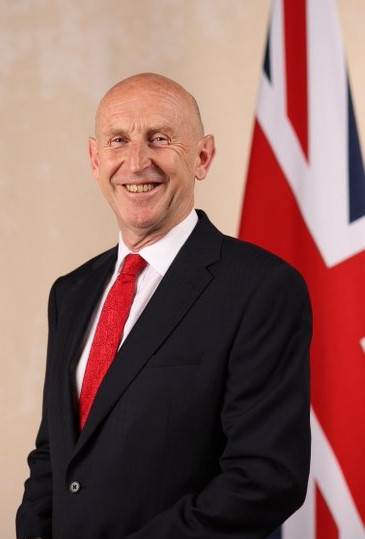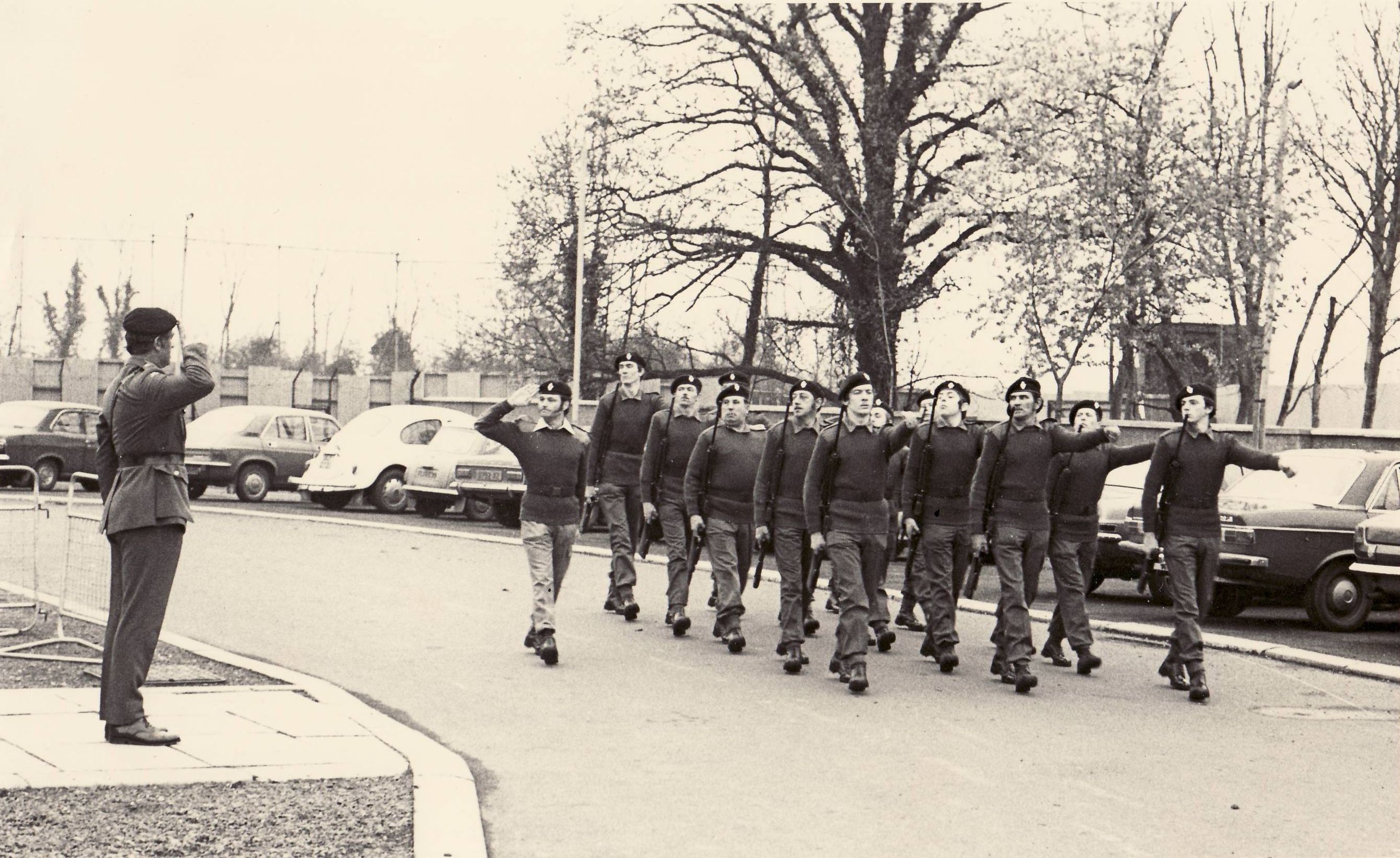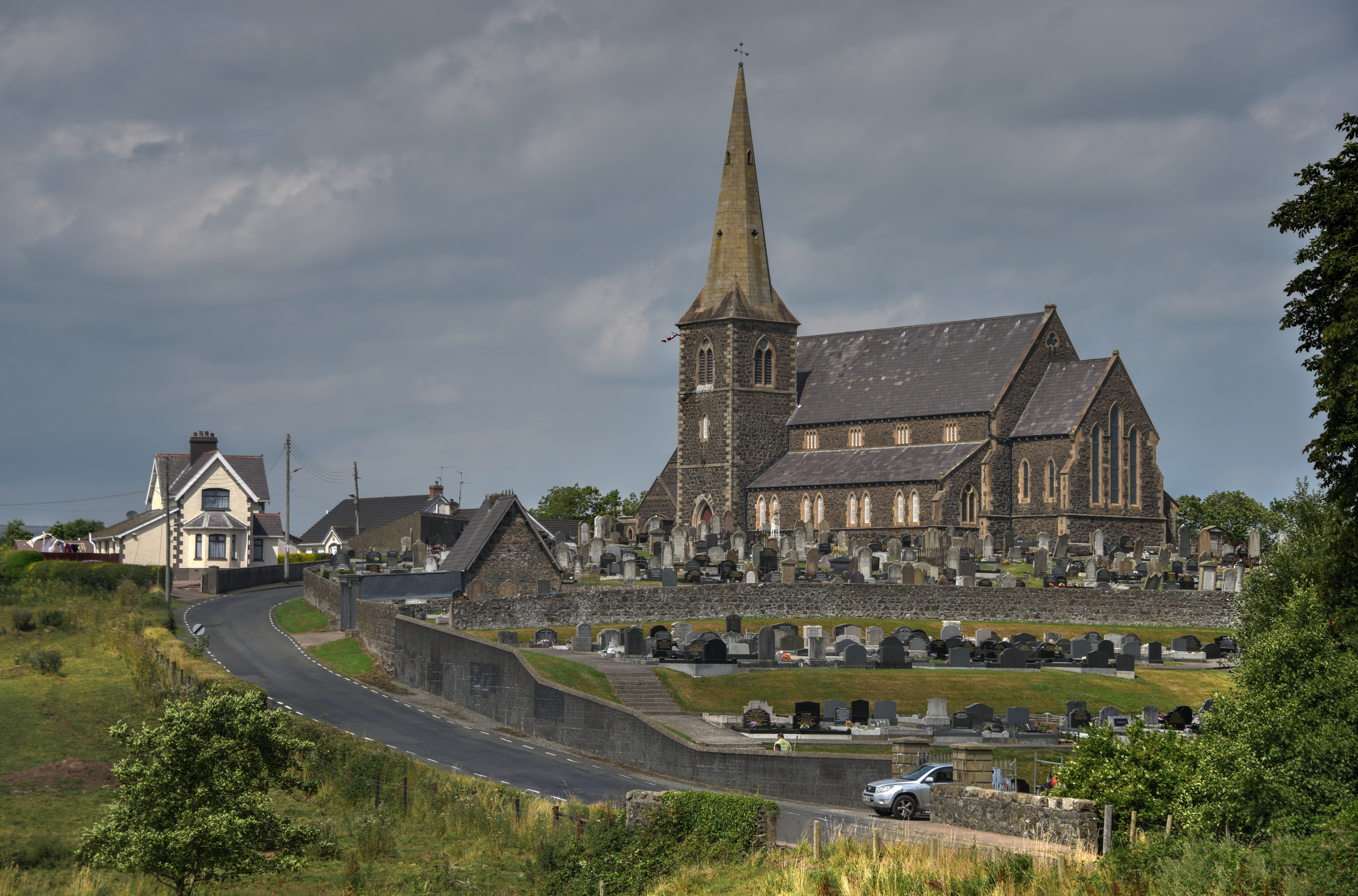|
Mahon Road Barracks
The Mahon Road Barracks was a military installation in Portadown, Northern Ireland. History The barracks were built on the Mahon Road in Portadown in 1972 to accommodate the 11th Battalion, Ulster Defence Regiment and were originally dubbed "Fort Mahon". In February 1974 the barracks also became the Headquarters for 3rd Infantry Brigade where the brigade's units included, along with Brigade Staff, 174 (Provost) Company, Royal Military Police. The barracks were also the home of G Squadron, 22nd SAS Regiment and were the centre of many of their operations in Northern Ireland including the interception of eight members of a Provisional Irish Republican Army team at Loughgall RUC Barracks in 1987; G Squadron operated under the working name of 4 Field Survey Troop, Royal Engineers. 3rd brigade was moved to Drumadd Barracks in Armagh in 1988 during a restructuring of land forces in Northern Ireland. In July 2000 the barracks were used by the security forces during the Drumcree co ... [...More Info...] [...Related Items...] OR: [Wikipedia] [Google] [Baidu] |
Portadown
Portadown ( ) is a town in County Armagh, Northern Ireland. The town is based on the River Bann in the north of the county, about southwest of Belfast. It is in the Armagh City, Banbridge and Craigavon Borough Council area and had a population of about 32,000 at the United Kingdom Census 2021, 2021 Census. For some purposes, Portadown is treated as part of the "Craigavon Urban Area", alongside Craigavon (planned town), Craigavon and Lurgan. Although Portadown was founded during the early 17th century English Plantation of Ulster, it was not until the Victorian era and the arrival of the railway that it developed as a major town. It earned the nickname "hub of the North" because it was a major railway junction; here the Great Northern Railway (Ireland), Great Northern Railway's line diverged for Belfast, Dublin, Armagh and Derry. In the 19th and 20th centuries, Portadown was also a major centre for the production of textiles (mainly Irish linen, linen). Portadown is the site of ... [...More Info...] [...Related Items...] OR: [Wikipedia] [Google] [Baidu] |
Northern Ireland
Northern Ireland ( ; ) is a Countries of the United Kingdom, part of the United Kingdom in the north-east of the island of Ireland. It has been #Descriptions, variously described as a country, province or region. Northern Ireland shares Republic of Ireland–United Kingdom border, an open border to the south and west with the Republic of Ireland. At the 2021 United Kingdom census, 2021 census, its population was 1,903,175, making up around 3% of the Demographics of the United Kingdom#Population, UK's population and 27% of the population on the island of Ireland#Demographics, Ireland. The Northern Ireland Assembly, established by the Northern Ireland Act 1998, holds responsibility for a range of Devolution, devolved policy matters, while other areas are reserved for the Government of the United Kingdom, UK Government. The government of Northern Ireland cooperates with the government of Ireland in several areas under the terms of the Good Friday Agreement. The Republic of Ireland ... [...More Info...] [...Related Items...] OR: [Wikipedia] [Google] [Baidu] |
Ministry Of Defence (United Kingdom)
The Ministry of Defence (MOD or MoD) is a Departments of the Government of the United Kingdom, ministerial department of the Government of the United Kingdom. It is responsible for implementing the defence policy set by the government and serves as the headquarters of the British Armed Forces. The MOD states that its principal objectives are to defend the United Kingdom of Great Britain and Northern Ireland and its interests and to strengthen international peace and stability. The MOD also manages day-to-day running of the armed forces, contingency planning and defence procurement. The expenditure, administration and policy of the MOD are scrutinised by the Defence Select Committee, except for Defence Intelligence which instead falls under the Intelligence and Security Committee of Parliament. History During the 1920s and 1930s, British civil servants and politicians, looking back at the performance of the state during World War I, concluded that there was a need for greater ... [...More Info...] [...Related Items...] OR: [Wikipedia] [Google] [Baidu] |
11th Battalion, Ulster Defence Regiment
The 11th (Craigavon) Battalion, Ulster Defence Regiment was formed from companies of the 2nd Battalion Ulster Defence Regiment (2 UDR) and the 3rd Battalion Ulster Defence Regiment in 1972. In 1991 under the reductions planned in Options for Change by the British Army, it again amalgamated with 2 UDR to form the 2nd/11th Battalion Ulster Defence Regiment. Formation The battalion was formed in 1972 after an announcement by Major General Robert Ford, Commander Land Forces in Northern Ireland (CLFNI).Ryder p49 The raising of the new and final battalion of the UDR brought operational strength up to 9,000 men, making the regiment not only the youngest but largest infantry battalion in the British Army. The new battalion was commanded by Lieutenant Colonel Robin Chappell, who had previously been commander of the neighbouring 2 UDR. He was the first regular officer to command the 2nd battalion, and the only regular officer ever to command two separate UDR battalions. In 1990 11 ... [...More Info...] [...Related Items...] OR: [Wikipedia] [Google] [Baidu] |
3rd Infantry Brigade (United Kingdom)
The 3rd Infantry Brigade was a Regular Army infantry brigade of the British Army, part of the 1st Infantry Division. Originally formed in 1809, during the Peninsular War, the brigade had a long history, seeing action in the Second Anglo-Afghan War, and during both the First and the Second World Wars. Formation The 1st Division was formed during the Peninsular War in Spain and Portugal, part of the army commanded by General Arthur Wellesley, later 1st Duke of Wellington. In 1814, the 3rd brigade took part in the Battle of New Orleans, commanded by Lt. Gen. John Keane. It also took part in the Battle of Ali Masjid in November 1878 during the Second Anglo-Afghan War. As the Second Boer War ended in 1902 the army was restructured, and a 2nd Infantry division was established permanently as part of the 1st Army Corps, comprising the 3rd and 4th Infantry Brigades. First World War The brigade saw service during the First World War as part of the British Expeditionary Force ... [...More Info...] [...Related Items...] OR: [Wikipedia] [Google] [Baidu] |
Royal Military Police
The Royal Military Police (RMP) is the corps of the British Army responsible for the policing of army service personnel, and for providing a military police presence both in the UK and while service personnel are deployed overseas on operations and exercises. Members of the RMP are often known as 'Redcaps' because of the scarlet covers on their peaked caps and scarlet coloured berets. The RMP's origins can be traced back to the 13th century but it was not until 1877 that a regular corps of military police was formed with the creation of the Military Mounted Police, which was followed by the Military Foot Police in 1885. Although technically two independent corps, they effectively functioned as a single organisation. In 1926, they were fully amalgamated to form the Corps of Military Police (CMP). In recognition of their service in the Second World War, they became the Corps of Royal Military Police on 28 November 1946. In 1992, the RMP amalgamated into the Adjutant General's Co ... [...More Info...] [...Related Items...] OR: [Wikipedia] [Google] [Baidu] |
Special Air Service
The Special Air Service (SAS) is a special forces unit of the British Army. It was founded as a regiment in 1941 by David Stirling, and in 1950 it was reconstituted as a corps. The unit specialises in a number of roles including counter-terrorism, hostage rescue, direct action (military), direct action and special reconnaissance. Much of the information about the SAS is highly classified information, classified, and the unit is not commented on by either the British government or the Ministry of Defence (United Kingdom), Ministry of Defence due to the secrecy and sensitivity of its operations. The corps currently consists of the 22 Special Air Service Regiment, which is the regular component, as well as the Artists Rifles, 21 Special Air Service Regiment (Artists) (Reserve) and the 23 Special Air Service Regiment (Reserve), which are reserve units, all under the operational command of United Kingdom Special Forces (UKSF). Its sister unit is the Royal Navy's Special Boat Servi ... [...More Info...] [...Related Items...] OR: [Wikipedia] [Google] [Baidu] |
Provisional Irish Republican Army
The Provisional Irish Republican Army (Provisional IRA), officially known as the Irish Republican Army (IRA; ) and informally known as the Provos, was an Irish republican paramilitary force that sought to end British rule in Northern Ireland, facilitate Irish reunification and bring about an independent republic encompassing all of Ireland. It was the most active republican paramilitary group during the Troubles. It argued that the all-island Irish Republic continued to exist, and it saw itself as that state's army, the sole legitimate successor to the original IRA from the Irish War of Independence. It was List of designated terrorist groups, designated a terrorist organisation in the United Kingdom and an unlawful organisation in the Republic of Ireland, both of whose authority it rejected. The Provisional IRA emerged in December 1969, due to a split within Irish Republican Army (1922–1969), the previous incarnation of the IRA and the broader Irish republican movement. It ... [...More Info...] [...Related Items...] OR: [Wikipedia] [Google] [Baidu] |
Loughgall
Loughgall ( ; ) is a small village, townland (of 131 acres) and Civil parishes in Ireland, civil parish in County Armagh, Northern Ireland. It is in the historic Barony (Ireland), baronies of Armagh (barony), Armagh and Oneilland West. It had a population of 282 people (in 116 households) as of the 2011 census. Loughgall was named after a small nearby loch. The village is surrounded by orchards. History In the Middle Ages the chiefs of the Oneilland, Uí Nialláin, a Gaelic Ireland, Gaelic clan, resided at Loughgall crannog, a fortified lake dwelling. By the 16th century the O'Neill dynasty, O'Neills of Tír Eoghain had taken over the area, and the crannog became the residence of the O'Neill chief's brother or eldest son. In the early 1600s, the area was settled by English and Scottish Protestants as part of the Ulster Plantation. During the 1641 Irish Rebellion, settlers were held at a prison camp at Loughgall by Catholic rebels led by Manus O'Cane. In 1795, rival sectarian ... [...More Info...] [...Related Items...] OR: [Wikipedia] [Google] [Baidu] |
Drumadd Barracks
Drumadd Barracks is a former military installation in Armagh, Northern Ireland. History The barracks were established on Hamiltonsbawn Road in Armagh in 1975. They became a base for 2nd Battalion, Ulster Defence Regiment in 1976, during the Troubles, and then became headquarters for 3rd Infantry Brigade, who moved from the Mahon Road Barracks in Portadown, in February 1988. The barracks were also the southern area regional command headquarters. In November 1996 a 2,500 lb bomb planted by the Provisional Irish Republican Army was found abandoned about half a mile from the barracks. In 2003 an ornate memorial window was unveiled at the barracks by Archbishop Robin Eames Robert Henry Alexander Eames, Baron Eames (born 27 April 1936) is an Anglican bishop and life peer, who served as Primate of All Ireland and Archbishop of Armagh from 1986 to 2006. Early life and education Eames was born in 1936, the son of .... The barracks were vacated in July 2007 and sold for redeve ... [...More Info...] [...Related Items...] OR: [Wikipedia] [Google] [Baidu] |
Armagh
Armagh ( ; , , " Macha's height") is a city and the county town of County Armagh, in Northern Ireland, as well as a civil parish. It is the ecclesiastical capital of Ireland – the seat of the Archbishops of Armagh, the Primates of All Ireland for both the Roman Catholic Church and the Church of Ireland. In ancient times, nearby Navan Fort () was a pagan ceremonial site and one of the great royal capitals of Gaelic Ireland. Today, Armagh is home to two cathedrals (both named after Saint Patrick) and the Armagh Observatory, and is known for its Georgian architecture. Statistically classed as a medium-sized town by NISRA, Armagh was given city status in 1994 and Lord Mayoralty status in 2012. It had a population of 16,310 people in the 2021 Census. History Foundation ''Eamhain Mhacha'' (or Navan Fort), at the western edge of Armagh, was an ancient pagan ritual or ceremonial site. According to Irish mythology it was one of the great royal sites of Gaelic ... [...More Info...] [...Related Items...] OR: [Wikipedia] [Google] [Baidu] |
Drumcree Conflict
The Drumcree conflict or Drumcree standoff is a dispute over yearly Parades in Northern Ireland, parades in the town of Portadown, Northern Ireland. The town is mainly Ulster Protestants, Protestant and hosts numerous Protestant marches each summer, but has a significant Irish Catholics, Catholic minority. The Orange Order insists that it should be allowed to Orange walk, march its traditional route to and from Drumcree Church on the Sunday before the The Twelfth, Twelfth of July. However, most of this route is through the mainly Catholic/Irish nationalism, Irish nationalist part of town. The residents, who see the march as sectarianism, sectarian, triumphalist and supremacism, supremacist, have sought to ban it from their area. There has been intermittent violence over the march since the 1800s. The outbreak of the Troubles led to the dispute intensifying in the 1970s and 1980s. At this time, the most contentious part of the route was the outward leg along Obins Street. After ... [...More Info...] [...Related Items...] OR: [Wikipedia] [Google] [Baidu] |








